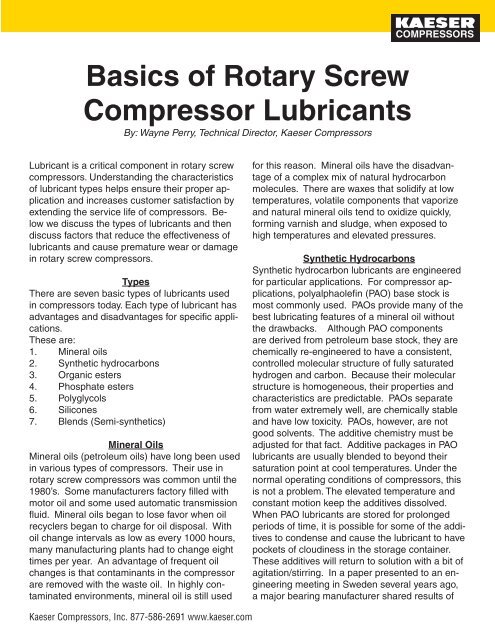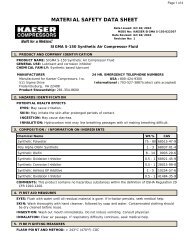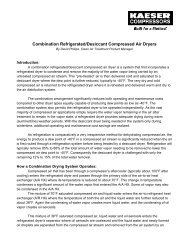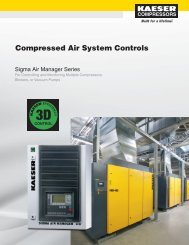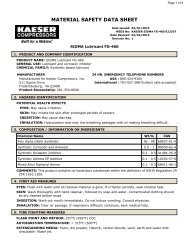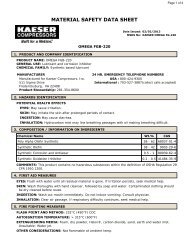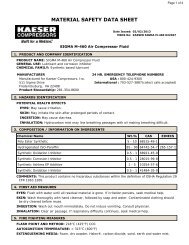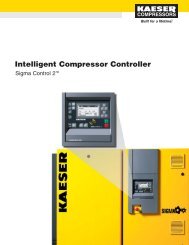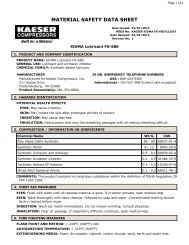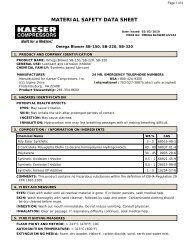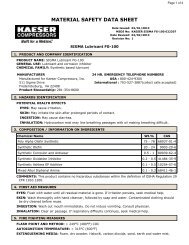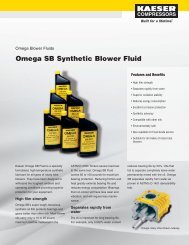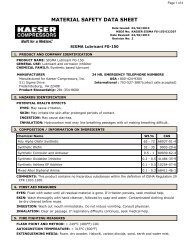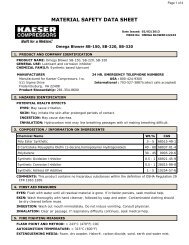Basics of rotary screw compressor lubricants - Kaeser Compressors
Basics of rotary screw compressor lubricants - Kaeser Compressors
Basics of rotary screw compressor lubricants - Kaeser Compressors
Create successful ePaper yourself
Turn your PDF publications into a flip-book with our unique Google optimized e-Paper software.
<strong>Basics</strong> <strong>of</strong> Rotary Screw<br />
Compressor Lubricants<br />
By: Wayne Perry, Technical Director, <strong>Kaeser</strong> <strong>Compressors</strong><br />
Lubricant is a critical component in <strong>rotary</strong> <strong>screw</strong><br />
<strong>compressor</strong>s. Understanding the characteristics<br />
<strong>of</strong> lubricant types helps ensure their proper application<br />
and increases customer satisfaction by<br />
extending the service life <strong>of</strong> <strong>compressor</strong>s. Below<br />
we discuss the types <strong>of</strong> <strong>lubricants</strong> and then<br />
discuss factors that reduce the effectiveness <strong>of</strong><br />
<strong>lubricants</strong> and cause premature wear or damage<br />
in <strong>rotary</strong> <strong>screw</strong> <strong>compressor</strong>s.<br />
Types<br />
There are seven basic types <strong>of</strong> <strong>lubricants</strong> used<br />
in <strong>compressor</strong>s today. Each type <strong>of</strong> lubricant has<br />
advantages and disadvantages for specific applications.<br />
These are:<br />
1. Mineral oils<br />
2. Synthetic hydrocarbons<br />
3. Organic esters<br />
4. Phosphate esters<br />
5. Polyglycols<br />
6. Silicones<br />
7. Blends (Semi-synthetics)<br />
Mineral Oils<br />
Mineral oils (petroleum oils) have long been used<br />
in various types <strong>of</strong> <strong>compressor</strong>s. Their use in<br />
<strong>rotary</strong> <strong>screw</strong> <strong>compressor</strong>s was common until the<br />
1980’s. Some manufacturers factory filled with<br />
motor oil and some used automatic transmission<br />
fluid. Mineral oils began to lose favor when oil<br />
recyclers began to charge for oil disposal. With<br />
oil change intervals as low as every 1000 hours,<br />
many manufacturing plants had to change eight<br />
times per year. An advantage <strong>of</strong> frequent oil<br />
changes is that contaminants in the <strong>compressor</strong><br />
are removed with the waste oil. In highly contaminated<br />
environments, mineral oil is still used<br />
for this reason. Mineral oils have the disadvantage<br />
<strong>of</strong> a complex mix <strong>of</strong> natural hydrocarbon<br />
molecules. There are waxes that solidify at low<br />
temperatures, volatile components that vaporize<br />
and natural mineral oils tend to oxidize quickly,<br />
forming varnish and sludge, when exposed to<br />
high temperatures and elevated pressures.<br />
Synthetic Hydrocarbons<br />
Synthetic hydrocarbon <strong>lubricants</strong> are engineered<br />
for particular applications. For <strong>compressor</strong> applications,<br />
polyalphaolefin (PAO) base stock is<br />
most commonly used. PAOs provide many <strong>of</strong> the<br />
best lubricating features <strong>of</strong> a mineral oil without<br />
the drawbacks. Although PAO components<br />
are derived from petroleum base stock, they are<br />
chemically re-engineered to have a consistent,<br />
controlled molecular structure <strong>of</strong> fully saturated<br />
hydrogen and carbon. Because their molecular<br />
structure is homogeneous, their properties and<br />
characteristics are predictable. PAOs separate<br />
from water extremely well, are chemically stable<br />
and have low toxicity. PAOs, however, are not<br />
good solvents. The additive chemistry must be<br />
adjusted for that fact. Additive packages in PAO<br />
<strong>lubricants</strong> are usually blended to beyond their<br />
saturation point at cool temperatures. Under the<br />
normal operating conditions <strong>of</strong> <strong>compressor</strong>s, this<br />
is not a problem. The elevated temperature and<br />
constant motion keep the additives dissolved.<br />
When PAO <strong>lubricants</strong> are stored for prolonged<br />
periods <strong>of</strong> time, it is possible for some <strong>of</strong> the additives<br />
to condense and cause the lubricant to have<br />
pockets <strong>of</strong> cloudiness in the storage container.<br />
These additives will return to solution with a bit <strong>of</strong><br />
agitation/stirring. In a paper presented to an engineering<br />
meeting in Sweden several years ago,<br />
a major bearing manufacturer shared results <strong>of</strong><br />
<strong>Kaeser</strong> <strong>Compressors</strong>, Inc. 877-586-2691 www.kaeser.com
White Paper: <strong>Basics</strong> <strong>of</strong> Rotary Screw Compressor Lubricants<br />
their testing <strong>of</strong> <strong>lubricants</strong> for use in <strong>rotary</strong> <strong>screw</strong><br />
<strong>compressor</strong>s. Their conclusion was that PAO<br />
<strong>lubricants</strong> were the best <strong>lubricants</strong> for rolling element<br />
bearings used in <strong>screw</strong> <strong>compressor</strong>s.<br />
Pure PAO fluids have a tendency to cause certain<br />
low nitrile Buna-N elastomers and some other<br />
synthetic materials to become brittle and crack.<br />
For <strong>compressor</strong> applications, a small amount <strong>of</strong><br />
ester fluid is usually blended in the mix to counter<br />
this tendency. The ester also helps keep additives<br />
in solution.<br />
Organic Esters<br />
The next class <strong>of</strong> synthetics is the organic esters.<br />
The two primary types used in <strong>compressor</strong>s are<br />
dibasic acid and polyol. Dibasic acid <strong>lubricants</strong><br />
are better known as diesters. Diesters were the<br />
most popular synthetic <strong>lubricants</strong> when synthetic<br />
<strong>lubricants</strong> first became common in <strong>compressor</strong><br />
applications in the 1970’s and 1980’s. They have<br />
a number <strong>of</strong> desirable qualities for <strong>compressor</strong><br />
applications. They have a stable viscosity over a<br />
wide temperature range, high film strength, good<br />
metal wetting characteristics and a low vapor<br />
pressure at high temperatures.<br />
Diesters are strong solvents. As such, they readily<br />
accept additives, making them customizable for<br />
particular applications. Being a strong solvent,<br />
however, is also one <strong>of</strong> their primary drawbacks.<br />
Diesters will dissolve paint and varnish, cause<br />
certain common elastomers to swell and deteriorate<br />
and can damage some common downstream<br />
components <strong>of</strong> compressed air distribution systems.<br />
Esters can react with water to form corrosive<br />
acids and volatile alcohols.<br />
Diesters are not commonly used in <strong>rotary</strong> <strong>screw</strong><br />
<strong>compressor</strong>s today, but still enjoy wide popularity<br />
among large reciprocating <strong>compressor</strong> users<br />
where the diesters’ solvency and resistance to<br />
carbon formation is a plus for extended valve<br />
life. Polyol esters have similar characteristics to<br />
diesters but have the added advantage <strong>of</strong> being<br />
stable at higher temperatures and oxygen<br />
concentrations. Although the primary market for<br />
polyol esters has been for use in turbines, these<br />
fluids are being used in some high-pressure <strong>rotary</strong><br />
<strong>screw</strong> applications.<br />
Phosphate Esters<br />
Phosphate esters have very limited application.<br />
Phosphate esters have a poor viscosity index,<br />
poor tolerance <strong>of</strong> heat and moisture and become<br />
corrosive as they degrade. For that reason,<br />
service life is very limited and fluid changes are<br />
required <strong>of</strong>ten. They can, however, be made fire<br />
resistant, and once ignited, they will only continue<br />
to burn if the source <strong>of</strong> ignition remains present.<br />
Petro-chemical plants, refineries and other highrisk<br />
facilities form the primary market for this type<br />
<strong>of</strong> lubricant.<br />
Polyglycols<br />
Polyglycol fluids, sometimes called PAG fluids<br />
(polyalkylene glycol), were first developed for<br />
natural gas <strong>compressor</strong>s. They can be manufactured<br />
from either <strong>of</strong> two primary chemical stocks,<br />
or a blend <strong>of</strong> these stocks. Propylene oxide has<br />
the characteristic <strong>of</strong> being hydrocarbon soluble<br />
and water insoluble. Ethylene oxide has opposite<br />
characteristics, being water-soluble and hydrocarbon<br />
insoluble. With a gas analysis, blenders can<br />
adjust the amount <strong>of</strong> each type to produce a final<br />
product with the correct characteristics required<br />
by an individual application. The solubility differences<br />
in the two basic fluids make the chemistry<br />
<strong>of</strong> the additive package very important. For<br />
natural gas applications, the fluids are blended so<br />
they are not diluted by the particular hydrocarbon<br />
gas being compressed.<br />
Polyglycol fluids for use in air <strong>compressor</strong>s are<br />
compromise fluids. They were developed to<br />
reduce complaints about poor lubricant life and<br />
varnish deposits. The formation <strong>of</strong> varnish is an<br />
indication <strong>of</strong> a petroleum or synthetic hydrocarbon<br />
lubricant that has failed. Since polyglycols<br />
do not form varnish, there is no visual indication<br />
that the lubricant has failed. Polyglycols attract<br />
water and mix readily. This characteristic makes<br />
<strong>Kaeser</strong> <strong>Compressors</strong>, Inc. 877-586-2691 www.kaeser.com
White Paper: <strong>Basics</strong> <strong>of</strong> Rotary Screw Compressor Lubricants<br />
separation from condensate difficult and reduces<br />
their ability to protect bearings. The saturation<br />
point for these <strong>lubricants</strong> is much higher than for<br />
mineral or synthetic hydrocarbon fluids, but water<br />
entrained in the fluid beyond this point will separate<br />
into free water.<br />
Silicones<br />
Silicone fluids have been available for many<br />
years. They have excellent resistance to heat,<br />
oxidation and vaporization. Being chemically<br />
inert, they can be used in applications where exposure<br />
to oxidizing agents is possible. High cost,<br />
leakage and poor lubricating properties limit their<br />
proper use to applications requiring their unique<br />
chemical characteristics. Further, there are many<br />
applications that require a silicone-free system,<br />
painting is one example, and silicone <strong>lubricants</strong><br />
should be avoided.<br />
Blends (Semi-Synthetics)<br />
Virtually all synthetic fluids, except silicones,<br />
are actually blends <strong>of</strong> base stocks and additives<br />
engineered to provide the desired characteristics.<br />
When a fluid is referred to as a semi-synthetic,<br />
it is usually a blend <strong>of</strong> a synthetic stock, usually<br />
a PAO, and most likely a “tech white” mineral oil.<br />
Tech white mineral oil is the most highly refined<br />
and homogenous petroleum oil available. It is<br />
<strong>of</strong>ten referred to as medical or food grade oil.<br />
The goal <strong>of</strong> most blends is to provide many <strong>of</strong><br />
the benefits <strong>of</strong> a pure synthetic at a lower cost. A<br />
good application for a blended fluid is one where<br />
contamination in the ambient air necessitates<br />
more frequent lubricant changes.<br />
Note: Food grade <strong>lubricants</strong> are usually either<br />
PAO-based or tech white mineral oil based with a<br />
very limited additive package. This limited additive<br />
package results in a significantly reduced<br />
service life when compared to non-food grade<br />
versions <strong>of</strong> the same lubricant.<br />
Causes <strong>of</strong> bearing damage in <strong>rotary</strong> <strong>screw</strong><br />
<strong>compressor</strong>s<br />
Water<br />
The most common and most damaging contaminant<br />
in <strong>rotary</strong> <strong>screw</strong> <strong>compressor</strong>s and <strong>rotary</strong><br />
<strong>screw</strong> vacuum pumps is water. The primary<br />
source <strong>of</strong> water contamination in <strong>rotary</strong> <strong>screw</strong><br />
<strong>compressor</strong>s is the inlet air. Ambient humidity<br />
and the <strong>compressor</strong>s operating conditions affect<br />
water formation in the lubricant circuit. A major<br />
bearing manufacturer has stated, “It is well known<br />
that free water in lubricating oil decreases the<br />
life <strong>of</strong> rolling element bearings by ten to more<br />
than one hundred times…”. When bearing life<br />
calculations are made, the assumption is that the<br />
lubricant contains 65 to 100 ppm <strong>of</strong> water. This is<br />
a normal amount <strong>of</strong> water that can be expected<br />
to be present in new PAO lubricant. An increase<br />
to 300 ppm will result in an actual bearing life <strong>of</strong><br />
about half the calculated life. Water content <strong>of</strong><br />
1000 ppm or more is not uncommon in operating<br />
<strong>compressor</strong>s.<br />
Water can be present in a <strong>compressor</strong>s’ lubricant<br />
circuit in both a dissolved state and a free state.<br />
Lubricants, like air, have a saturation point. Depending<br />
on the type <strong>of</strong> lubricant, a certain amount<br />
<strong>of</strong> water will be dissolved in the fluid. Once the<br />
lubricant reaches its saturation point, additional<br />
water will condense to form free water. The extreme<br />
examples are pure PAO base stocks that<br />
have non-polar molecules and polyglycol <strong>lubricants</strong><br />
that have highly polarized molecules. PAO<br />
<strong>lubricants</strong> are sometimes described as being<br />
hydrophobic because they do not easily combine<br />
with water, reaching their room temperature saturation<br />
point at just over 100 ppm. PAO <strong>lubricants</strong><br />
separate from water readily so the free water can<br />
be easily drained from the <strong>compressor</strong>. Polyglycol<br />
<strong>lubricants</strong>, on the other hand, are sometimes<br />
described as hydroscopic. They combine readily<br />
with water and can be found with as much as<br />
one percent <strong>of</strong> their volume as water molecules<br />
(10,000 ppm).<br />
<strong>Kaeser</strong> <strong>Compressors</strong>, Inc. 877-586-2691 www.kaeser.com
White Paper: <strong>Basics</strong> <strong>of</strong> Rotary Screw Compressor Lubricants<br />
Rolling element bearings, like those used in<br />
<strong>rotary</strong> <strong>screw</strong> <strong>compressor</strong>s, rely on elastohydrodynamic<br />
lubrication. That means that the elements<br />
ride on a film <strong>of</strong> lubricant as they roll across the<br />
race. Lubricants are formulated to have sufficient<br />
film strength to prevent contact between the elements<br />
and the race. The viscosity <strong>of</strong> <strong>lubricants</strong><br />
increases as pressure increases. Under the extreme<br />
conditions found in bearing lubrication, the<br />
lubricant can momentarily become a solid. Water,<br />
however, does not increase in viscosity as pressure<br />
increases. Dissolved water can weaken the<br />
film strength <strong>of</strong> some <strong>lubricants</strong> and free water<br />
has no effective film strength in this type <strong>of</strong> application.<br />
As a roller or ball encounters water, there<br />
is insufficient film strength to prevent the element<br />
from contacting the race. This contact, under<br />
conditions <strong>of</strong> extreme pressure, can cause micr<strong>of</strong>ractures.<br />
Continued exposure to water can also<br />
cause a condition known as hydrogen embrittlement,<br />
increasing the formation <strong>of</strong> micro-fractures.<br />
This will continue until small flakes <strong>of</strong> the bearing<br />
surface begin to break away. This debris moving<br />
through the bearing will cause additional damage<br />
and lead to the failure <strong>of</strong> the bearing.<br />
When standard petroleum oils were used in <strong>rotary</strong><br />
<strong>screw</strong> <strong>compressor</strong>s, the accumulated water<br />
was removed when the oil was changed about<br />
every six weeks (1000 hours). With extended life<br />
synthetic <strong>lubricants</strong>, water may accumulate for<br />
8000 hours if it is not drained from the separator<br />
reservoir periodically. Without regular monitoring,<br />
significant amounts <strong>of</strong> water can collect in the<br />
lubrication circuit and reduced bearing life can be<br />
expected.<br />
Particulate<br />
Second to water, the most common contaminant<br />
is particulate. In operation, rolling element bearings<br />
ride on a film <strong>of</strong> lubricant that is from 0.1<br />
to 1.0 micron thick. Any particulate larger than<br />
that can cause damage to the bearing. Filtering<br />
to one tenth <strong>of</strong> a micron is impractical for most<br />
applications. Even filtering to one micron is dif-<br />
<strong>Kaeser</strong> <strong>Compressors</strong>, Inc. 877-586-2691 www.kaeser.com
White Paper: <strong>Basics</strong> <strong>of</strong> Rotary Screw Compressor Lubricants<br />
ficult. Most bearing manufacturers take this into<br />
account when calculating L10 bearing life. They<br />
use the assumption that the lubricant will meet<br />
the ISO Base-Cleanliness Target for rolling element<br />
bearings.<br />
Fluid cleanliness rated per the ISO Code is<br />
reported as a three-number rating such as<br />
18/16/13. The first number (in this example,<br />
18) represents the number <strong>of</strong> particles per milliliter<br />
(about an eyedropper full) <strong>of</strong> fluid that were<br />
greater than or equal to 4 microns. The second<br />
number represents the number <strong>of</strong> particles that<br />
were greater than or equal to 6 microns. The last<br />
number represents the number <strong>of</strong> particles that<br />
were greater than or equal to 14 microns. In the<br />
above example, there would be between 1300<br />
and 2500 particles greater than or equal to 4 microns,<br />
320 to 640 particles greater than or equal<br />
to 6 microns and 40 to 80 particles greater than<br />
or equal to 14 microns. Each increase in rating<br />
number represents an approximate doubling<br />
<strong>of</strong> the number <strong>of</strong> particulates. The ISO Base-<br />
Cleanliness Target for new fluid for rolling element<br />
bearing lubrication is 16/14/12.<br />
ISO 4406:1999 Fluid Cleanliness Codes<br />
Number <strong>of</strong> Particles per 1 milliliter <strong>of</strong> Fluid<br />
ISO Code Minimum Maximum<br />
1 0.01 0.02<br />
2 0.02 0.04<br />
3 0.04 0.08<br />
4 0.08 0.16<br />
5 0.16 0.32<br />
6 0.32 0.64<br />
7 0.64 1.3<br />
8 1.3 2.5<br />
9 2.5 5.0<br />
10 5.0 10.0<br />
11 10.0 20.0<br />
12 20.0 40.0<br />
13 40.0 80.0<br />
14 80.0 160<br />
15 160 320<br />
16 320 640<br />
17 640 1300<br />
18 1300 2500<br />
19 2500 5000<br />
20 5000 10000<br />
21 10000 20000<br />
22 20000 40000<br />
23 40000 80000<br />
24 80000 160000<br />
25 160000 320000<br />
26 320000 640000<br />
27 640000 1300000<br />
<strong>Kaeser</strong> <strong>Compressors</strong>, Inc. 877-586-2691 www.kaeser.com<br />
Most analysis programs report only a two-number<br />
rating. This two-number reporting is either based<br />
on an older (pre-1999) reporting method that<br />
counted 5 and 15 micron particles or simply the<br />
last two numbers <strong>of</strong> the three-number system.<br />
There is a slight difference between the 5 and<br />
15 micron rating and the 6 and 14 micron rating<br />
<strong>of</strong> the newer system, but the practical results are<br />
similar. In other words, the ISO Base-Cleanliness<br />
Target for new fluid for rolling element bearing<br />
lubrication, which is 16/14/12, could also be reported<br />
as 14/12.<br />
Knowing the average ISO 4406 numbers for a<br />
particular <strong>compressor</strong> over an extended period <strong>of</strong>
White Paper: <strong>Basics</strong> <strong>of</strong> Rotary Screw Compressor Lubricants<br />
time will allow estimation <strong>of</strong> the particulate contamination’s<br />
effect on bearing life. The following<br />
chart can be used to make a quick estimate.<br />
Using this chart is simple. If the analysis report<br />
stated the ISO 4066 as 21/18, for example,<br />
cleaning the lubricant to the point that the rating<br />
improved to 15/12 would increase the expected<br />
bearing life 300%. Another way to look at this<br />
is that the lubricant started at 15/12 and is now<br />
21/18. At 21/18 the expected lubricant life is only<br />
one third <strong>of</strong> what it would be at 15/12.<br />
<strong>Kaeser</strong> <strong>Compressors</strong>, Inc. 877-586-2691 www.kaeser.com
White Paper: <strong>Basics</strong> <strong>of</strong> Rotary Screw Compressor Lubricants<br />
The primary source <strong>of</strong> particulate contamination<br />
in <strong>rotary</strong> <strong>screw</strong> <strong>compressor</strong>s is the inlet air. Dirt<br />
and dust making their way through the inlet filter<br />
will show in lubricant sample tests as silicon (or<br />
silica) and possibly aluminum. While dirt and<br />
dust can have different elemental constituents,<br />
including magnesium and calcium, silicon oxides<br />
and aluminum oxides are the most common.<br />
The presence <strong>of</strong> barium, boron, molybdenum,<br />
phosphorous, and zinc in an oil sample are <strong>of</strong><br />
less concern because they are common additives<br />
to <strong>lubricants</strong>. (though increased levels <strong>of</strong> zinc<br />
and copper in subsequent samples could indicate<br />
wear conditions <strong>of</strong> brass components.) If these<br />
elements are found in a sample, where they were<br />
not present in prior samples, it could indicate that<br />
the lubricant was contaminated with another type<br />
<strong>of</strong> fluid. If these elements are found in the first<br />
sample, but are not in the original lubricant formula,<br />
it could indicate a contaminated transfer pump.<br />
It is important to remember that the additive package<br />
in one lubricant may react with the additive<br />
package in another lubricant. For this reason, do<br />
not mix brands <strong>of</strong> lubricant. This may lead to the<br />
premature failure <strong>of</strong> the fluid.<br />
Note: Chromium, cobalt, copper, magnesium,<br />
manganese, nickel and iron particulate in an oil<br />
sample are indicative <strong>of</strong> metal wear.<br />
Additive depletion is also accelerated by the presence<br />
<strong>of</strong> water and wear particles. Many <strong>of</strong> the<br />
additives consist <strong>of</strong> polar molecules. This makes<br />
them attracted to solid surfaces such as internal<br />
metal components. Some additives are specifically<br />
designed for this so they will combine with<br />
metal contaminants, making them easier to filter<br />
out <strong>of</strong> the lubricant system. Other (anti-corrosion)<br />
additives will adhere to internal metal surfaces to<br />
prevent corrosion.<br />
Oxidation<br />
Because they are mixed with air at high temperatures<br />
under pressure, all air <strong>compressor</strong><br />
<strong>lubricants</strong> will oxidize eventually. The oxidation <strong>of</strong><br />
<strong>lubricants</strong> produces a number <strong>of</strong> unwanted effects.<br />
As the lubricant begins to oxidize, organic<br />
peroxides will form. As the lubricant continues to<br />
oxidize, alcohols, ketones and organic acids will<br />
form. These compounds will show as an increase<br />
in the Total Acid Number (TAN) on a fluid analysis<br />
report. With synthetic hydrocarbon <strong>lubricants</strong>, a<br />
TAN increase to 1 is cause for alarm and a TAN<br />
increase <strong>of</strong> 1.5 indicates a fluid on the verge <strong>of</strong><br />
failure. Varnish and other unwanted substances<br />
quickly follow. With regular mineral oils, this<br />
process can begin after only one to two thousand<br />
hours in a <strong>rotary</strong> <strong>screw</strong> <strong>compressor</strong>. Synthetic<br />
<strong>lubricants</strong> are more stable than natural mineral<br />
oils and oxidize more slowly. Most full synthetics<br />
have an 8000-hour service life rating or more.<br />
Note that Food Grade <strong>lubricants</strong> behave differently!<br />
Consult the manufacturer to determine the<br />
behavior over time <strong>of</strong> a specific lubricant.<br />
When PAO synthetics were first introduced, their<br />
additive packages were not well engineered. As<br />
the anti-oxidant package was depleted and the<br />
fluid reached the end <strong>of</strong> its service life, the lubricant<br />
could progress from good to completely polymerized<br />
(varnish) in a matter <strong>of</strong> days. Although<br />
newer formulated additive packages have greatly<br />
reduced this problem, synthetics should still be<br />
changed when they reach their service hour or<br />
calendar life, regardless <strong>of</strong> sample analysis.<br />
Some <strong>of</strong> the byproducts <strong>of</strong> a lubricant that is very<br />
near the end <strong>of</strong> its useful life will likely remain in<br />
the lubrication system after it has been drained.<br />
It is very important to remove as much <strong>of</strong> the old<br />
lubricant as possible. The additive package <strong>of</strong> the<br />
new lubricant will react to these byproducts as<br />
contamination, rapidly depleting the additives in<br />
the new lubricant. It is not unusual for the life <strong>of</strong><br />
fresh lubricant to be reduced to as little as 25% <strong>of</strong><br />
its expected life when the system is not completely<br />
and thoroughly drained and cleaned. For this<br />
reason, it is important to remove the fluid while it<br />
is still in good condition and not wait until it has<br />
started to form these byproducts.<br />
<strong>Kaeser</strong> <strong>Compressors</strong>, Inc. 877-586-2691 www.kaeser.com
White Paper: <strong>Basics</strong> <strong>of</strong> Rotary Screw Compressor Lubricants<br />
Storage, handling and transferring <strong>lubricants</strong> affect<br />
the cleanliness <strong>of</strong> the fluid. It is very important<br />
to use only clean, dedicated containers and<br />
transfer pumps. Do not use one pump for several<br />
different fluids. Even a small amount <strong>of</strong> residual<br />
fluid in a pump can contaminate an entire sump.<br />
Conclusion<br />
Lubricant is a critical component in <strong>rotary</strong> <strong>screw</strong><br />
<strong>compressor</strong>s. Its condition is the key element in<br />
determining the service life <strong>of</strong> the machine, and it<br />
is constantly exposed to contamination. In order<br />
to maximize the service life <strong>of</strong> the <strong>compressor</strong>,<br />
follow these rules:<br />
1. Locate the <strong>compressor</strong> inlet to draw clean,<br />
cool air.<br />
2. If the <strong>compressor</strong> is air-cooled, provide<br />
clean, cool air to inlet <strong>of</strong> the cooling air system.<br />
Keep coolers clean.<br />
3. If the <strong>compressor</strong> is water-cooled, provide<br />
clean, cool water to the heat exchanger. Clean or<br />
replace the cooler if it becomes fouled. Fouling<br />
restricts heat transfer.<br />
4. Sample the lubricant frequently.<br />
5. Stop the <strong>compressor</strong> once per week and<br />
check for water in the separator reservoir. Drain<br />
<strong>of</strong>f any water found. In hot and humid environments,<br />
this may have to be done more <strong>of</strong>ten.<br />
6. Inlet filtration is the first line <strong>of</strong> defense.<br />
Clean the inlet filter <strong>of</strong>ten and replace when<br />
required. Examine the connection between the<br />
filter and the airend for leaks to make certain no<br />
ambient air is drawn in behind the filter. Check<br />
filter fit for a good seal.<br />
7. Change the lubricant before it gets near<br />
the end <strong>of</strong> its life. Depleted lubricant left in a<br />
<strong>compressor</strong> (even a relatively small amount) can<br />
significantly reduce the service life <strong>of</strong> the new<br />
lubricant. If the lubricant has started to fail, use a<br />
lubricant flush prior to changing the fluid.<br />
8. Properly apply <strong>compressor</strong>s to avoid low<br />
duty cycles, keeping temperatures within their<br />
designed operating range.<br />
Contact us to learn more:<br />
<strong>Kaeser</strong> <strong>Compressors</strong>, Inc.<br />
877-586-2691<br />
www.kaeser.com<br />
info.usa@kaeser.com<br />
<strong>Kaeser</strong> <strong>Compressors</strong>, Inc. 877-586-2691 www.kaeser.com


